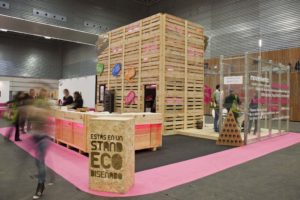Are we able to differentiate a sustainable product from an unsustainable one? Do we have the right information and training to be able to do so? Can a booth also be a recognizable sustainable product?
If between equivalent industrial products it is difficult to establish a valid comparison of the environmental impact caused, between different projects of ephemeral architecture, the task becomes an invitation to flee. As we need to compare similar elements with each other, we can start by dividing the booth into the usual basic elements: floor, walls, lighting/electricity, graphic supports and furniture. But, as I will try to show below, this division is only valid for the presentation and comparison of results, not for designing stands based on individualized impacts.
The Life Cycle Assessment (LCA) provides the environmental impact data of all the elements present in any product or service, and is the basic scientific tool to carry out an eco-design project. Using LCA programs, comparisons are made to select the best options at each stage: procurement, production, transportation, assembly, use, disassembly and end of life. At this point is where you must have a global vision to create an effective eco-design project and not a sum of independent environmental decisions, since all the elements of the stand interact with each other, generating environmental impacts that must be foreseen. The ecodesigner’s in-depth knowledge of the industry and all the details of each project should alert him/her to the potential side effects of the proposed solutions; and the support of the comprehensive project LCA allows the overall impact generated by each small change to be seen.
This phase is the absolute key to achieving environmental improvement in any new product, in fact it is estimated that 80% of the total environmental impact of a product is established at the design stage. Well-intended modifications throughout the project may reduce the impact of that particular element but increase the overall impact. It is best to see it with examples:
– Bamboo is a material with a low environmental impact, but if it has to be brought from Central America or Asia, the impact associated with the transportation phase must be calculated and the real impact of the use of this material in the place where the project is to be developed must be assessed.
– Vinyl may have less impact than some rigid graphic media but it needs a solid element behind it with a concrete finish in order to be properly affixed.
– Jointing techniques without auxiliary elements, such as tongue and groove, require production work (wood cutting) with its associated impacts, but avoid the use of lag screws and electrical consumption during the assembly phase, and greatly facilitate reuse and end-of-life management.
All the solutions that we can come up with in the design phase have their counterparts; ecodesign consists of pooling them with the aim of reducing the total impact of the entire product life cycle.
Conclusion: The data of the LCA programs allow to establish units of comparison between stands such as Kg of CO2 emitted per m2 of stand and once made known to the attendees of a fair, it is possible to see the environmental improvement that the eco-design brings to the ephemeral architecture sector.


